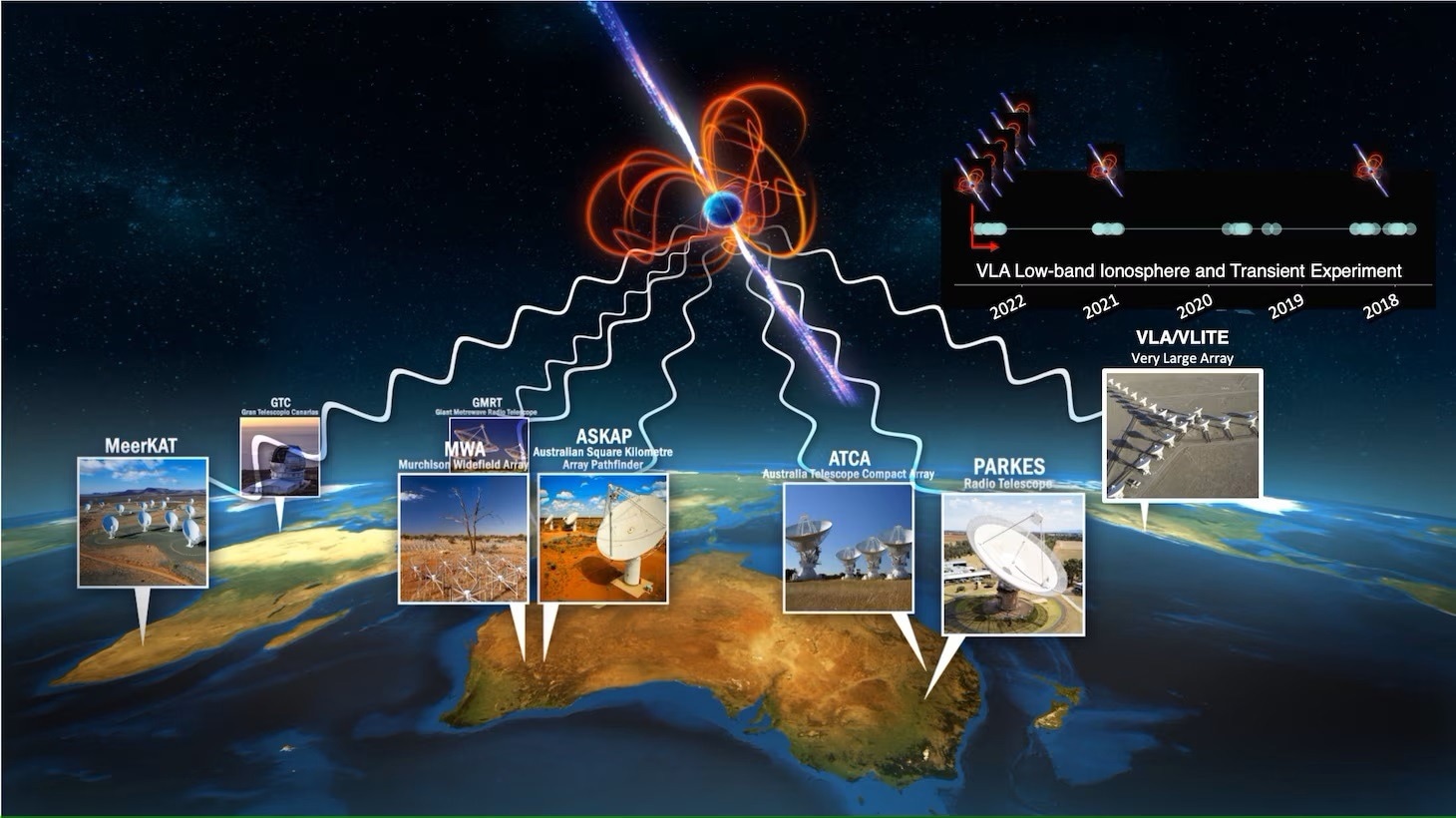The U.S. Naval Research Laboratory’s Very Large Array (VLA) Low-band Ionosphere and Transient Experiment (VLITE) telescope has aided astronomers in verifying the results of a novel stellar phenomenon that challenges existing scientific understanding of the physics of neutron stars. The object is thought to be an ultra-long period magnetar, a rare kind of star with very powerful magnetic fields that can generate strong bursts of energy, a result that was published in Nature.

Artist impression of the magnetar that was discovered by the Murchison Widefield Array (MWA) radio telescope and other radio facilities around the world that helped confirm the discovery. Looking back in time using archival data from NRL’s VLITE instrument on the VLA, NRL astronomers were able to time the radio bursts back to 2018. The inset timeline (top right) of VLITE archival observations shows the MWA discovery as a red bar, blue dots are VLITE data sets searched and thumbnails of the magnetar show when VLITE detected the emission. MeerKAT - Credit: South African Radio Astronomy Observatory (SARAO), Gran Telescopio Canarias - Credit: Daniel López/IAC, Murchison Widefield Array - Credit: Marianne Annereau, Giant Metrewave Radio Telescope - Credit: NCRA, Australian SKA Pathfinder - Credit: CSIRO/DragonflyMedia, Australia Telescope Compact Array - Credit: CSIRO, Parkes Radio Telescope, Murriyang - Credit: CSIRO, Very Large Array - Credit: AUI/NRAO
VLITE of NRL was built in association with the National Radio Astronomy Observatory in 2014. VLITE functions on the VLA as an independent instrument for astrophysical and ionospheric research. VLITE’s 18 antennas gather more than 6000 hours of data/year, which are attained at NRL.
Initially, it was implemented to continuously track the Earth’s ionosphere to research disturbances that can impact it, like seismic events, geomagnetic storms, and gravity waves. By this continuous monitoring, it can be employed as an instrument to sense transient blips, bursts of radio waves from cosmic sources that are subtle without continuous surveillance. Comprehending such phenomena might direct astronomers to an improved comprehension of the Universe.
In September 2022, a global team of astronomers, headed by Curtin University and the International Centre for Radio Astronomy Research (ICRAR) in Australia, found the stellar object (known as GPM J1839-10) with the use of the Murchison Widefield Array (MWA).
The breakthrough started an intense global attempt to understand GPM J1839-10. Quickly, NRL astronomers reprocessed stored VLITE data, finding previously hidden emissions from the stellar object. Equipped with the VLITE outcomes, astronomers scoured archives and traced the emission from the source back over 30 years to 1988.
“This enigmatic object has been hiding in the data for decades – we just did not know we had to look for it until its discovery by the MWA,” stated Dr. Simona Giacintucci, NRL Research Astronomer. GPM J1839-10 releases a five-minute pulse of radio wavelength emission every 22 minutes, and it has been doing this for a minimum of 33 years.
Findings like this are exciting because they highlight the gaps in our understanding of the physics of these extreme stars known as magnetars. Current understanding says this object should not emit radio waves and yet we are detecting them across several decades and we are not sure why. That is an exciting mystery.
Dr. Tracy Clarke, Research Astronomer and VLITE Project Scientist, U.S. Naval Research Laboratory
Astronomers hope GPM J1839−10 is a type of rare neutron star with very strong magnetic fields.
Astronomy is one of those bizarre professions where we are not able to go to our objects to study them. We are interested in how many of these are out there and where they are located. That is directing future research.
Dr. Tracy Clarke, Research Astronomer and VLITE Project Scientist, U.S. Naval Research Laboratory
VLITE has surpassed its mission, achieving its original goal of making breakthroughs like this. NRL astronomers will keep searching data sets generated with VLITE to guide future breakthroughs and an improved understanding of the Universe with its captivating objects. NRL’s instrumentation and advanced research aid in the mission of the Navy and Department of Defense while continuing to encourage science all over the world.